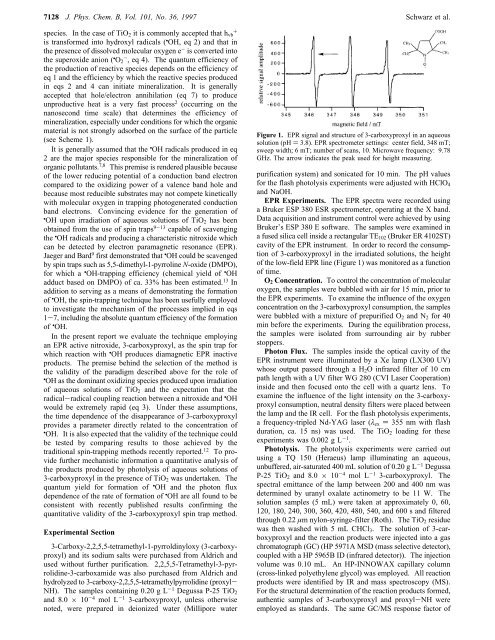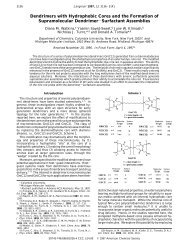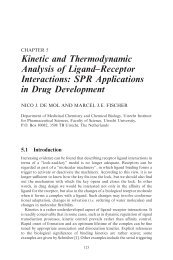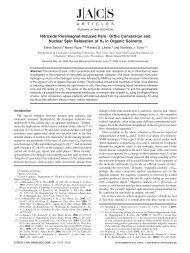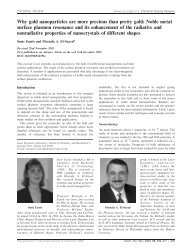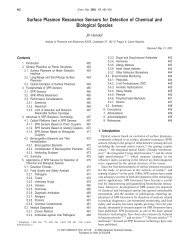A New Method To Determine the Generation of Hydroxyl Radicals in ...
A New Method To Determine the Generation of Hydroxyl Radicals in ...
A New Method To Determine the Generation of Hydroxyl Radicals in ...
Create successful ePaper yourself
Turn your PDF publications into a flip-book with our unique Google optimized e-Paper software.
7128 J. Phys. Chem. B, Vol. 101, No. 36, 1997 Schwarz et al.<br />
species. In <strong>the</strong> case <strong>of</strong> TiO2 it is commonly accepted that hvb +<br />
is transformed <strong>in</strong>to hydroxyl radicals ( • OH, eq 2) and that <strong>in</strong><br />
<strong>the</strong> presence <strong>of</strong> dissolved molecular oxygen e - is converted <strong>in</strong>to<br />
<strong>the</strong> superoxide anion ( • O2 - , eq 4). The quantum efficiency <strong>of</strong><br />
<strong>the</strong> production <strong>of</strong> reactive species depends on <strong>the</strong> efficiency <strong>of</strong><br />
eq 1 and <strong>the</strong> efficiency by which <strong>the</strong> reactive species produced<br />
<strong>in</strong> eqs 2 and 4 can <strong>in</strong>itiate m<strong>in</strong>eralization. It is generally<br />
accepted that hole/electron annihilation (eq 7) to produce<br />
unproductive heat is a very fast process 2 (occurr<strong>in</strong>g on <strong>the</strong><br />
nanosecond time scale) that determ<strong>in</strong>es <strong>the</strong> efficiency <strong>of</strong><br />
m<strong>in</strong>eralization, especially under conditions for which <strong>the</strong> organic<br />
material is not strongly adsorbed on <strong>the</strong> surface <strong>of</strong> <strong>the</strong> particle<br />
(see Scheme 1).<br />
It is generally assumed that <strong>the</strong> • OH radicals produced <strong>in</strong> eq<br />
2 are <strong>the</strong> major species responsible for <strong>the</strong> m<strong>in</strong>eralization <strong>of</strong><br />
organic pollutants. 7,8 This premise is rendered plausible because<br />
<strong>of</strong> <strong>the</strong> lower reduc<strong>in</strong>g potential <strong>of</strong> a conduction band electron<br />
compared to <strong>the</strong> oxidiz<strong>in</strong>g power <strong>of</strong> a valence band hole and<br />
because most reducible substrates may not compete k<strong>in</strong>etically<br />
with molecular oxygen <strong>in</strong> trapp<strong>in</strong>g photogenerated conduction<br />
band electrons. Conv<strong>in</strong>c<strong>in</strong>g evidence for <strong>the</strong> generation <strong>of</strong><br />
• OH upon irradiation <strong>of</strong> aqueous solutions <strong>of</strong> TiO2 has been<br />
obta<strong>in</strong>ed from <strong>the</strong> use <strong>of</strong> sp<strong>in</strong> traps 9-13 capable <strong>of</strong> scaveng<strong>in</strong>g<br />
<strong>the</strong> • OH radicals and produc<strong>in</strong>g a characteristic nitroxide which<br />
can be detected by electron paramagnetic resonance (EPR).<br />
Jaeger and Bard 9 first demonstrated that • OH could be scavenged<br />
by sp<strong>in</strong> traps such as 5,5-dimethyl-1-pyrrol<strong>in</strong>e N-oxide (DMPO),<br />
for which a • OH-trapp<strong>in</strong>g efficiency (chemical yield <strong>of</strong> • OH<br />
adduct based on DMPO) <strong>of</strong> ca. 33% has been estimated. 13 In<br />
addition to serv<strong>in</strong>g as a means <strong>of</strong> demonstrat<strong>in</strong>g <strong>the</strong> formation<br />
<strong>of</strong> • OH, <strong>the</strong> sp<strong>in</strong>-trapp<strong>in</strong>g technique has been usefully employed<br />
to <strong>in</strong>vestigate <strong>the</strong> mechanism <strong>of</strong> <strong>the</strong> processes implied <strong>in</strong> eqs<br />
1-7, <strong>in</strong>clud<strong>in</strong>g <strong>the</strong> absolute quantum efficiency <strong>of</strong> <strong>the</strong> formation<br />
<strong>of</strong> • OH.<br />
In <strong>the</strong> present report we evaluate <strong>the</strong> technique employ<strong>in</strong>g<br />
an EPR active nitroxide, 3-carboxyproxyl, as <strong>the</strong> sp<strong>in</strong> trap for<br />
which reaction with • OH produces diamagnetic EPR <strong>in</strong>active<br />
products. The premise beh<strong>in</strong>d <strong>the</strong> selection <strong>of</strong> <strong>the</strong> method is<br />
<strong>the</strong> validity <strong>of</strong> <strong>the</strong> paradigm described above for <strong>the</strong> role <strong>of</strong><br />
• OH as <strong>the</strong> dom<strong>in</strong>ant oxidiz<strong>in</strong>g species produced upon irradiation<br />
<strong>of</strong> aqueous solutions <strong>of</strong> TiO2 and <strong>the</strong> expectation that <strong>the</strong><br />
radical-radical coupl<strong>in</strong>g reaction between a nitroxide and • OH<br />
would be extremely rapid (eq 3). Under <strong>the</strong>se assumptions,<br />
<strong>the</strong> time dependence <strong>of</strong> <strong>the</strong> disappearance <strong>of</strong> 3-carboxyproxyl<br />
provides a parameter directly related to <strong>the</strong> concentration <strong>of</strong><br />
• OH. It is also expected that <strong>the</strong> validity <strong>of</strong> <strong>the</strong> technique could<br />
be tested by compar<strong>in</strong>g results to those achieved by <strong>the</strong><br />
traditional sp<strong>in</strong>-trapp<strong>in</strong>g methods recently reported. 12 <strong>To</strong> provide<br />
fur<strong>the</strong>r mechanistic <strong>in</strong>formation a quantitative analysis <strong>of</strong><br />
<strong>the</strong> products produced by photolysis <strong>of</strong> aqueous solutions <strong>of</strong><br />
3-carboxyproxyl <strong>in</strong> <strong>the</strong> presence <strong>of</strong> TiO2 was undertaken. The<br />
quantum yield for formation <strong>of</strong> • OH and <strong>the</strong> photon flux<br />
dependence <strong>of</strong> <strong>the</strong> rate <strong>of</strong> formation <strong>of</strong> • OH are all found to be<br />
consistent with recently published results confirm<strong>in</strong>g <strong>the</strong><br />
quantitative validity <strong>of</strong> <strong>the</strong> 3-carboxyproxyl sp<strong>in</strong> trap method.<br />
Experimental Section<br />
3-Carboxy-2,2,5,5-tetramethyl-1-pyrrold<strong>in</strong>yloxy (3-carboxyproxyl)<br />
and its sodium salts were purchased from Aldrich and<br />
used without fur<strong>the</strong>r purification. 2,2,5,5-Tetramethyl-3-pyrrolid<strong>in</strong>e-3-carboxamide<br />
was also purchased from Aldrich and<br />
hydrolyzed to 3-carboxy-2,2,5,5-tetramethylpyrrolid<strong>in</strong>e (proxyl-<br />
NH). The samples conta<strong>in</strong><strong>in</strong>g 0.20 g L -1 Degussa P-25 TiO2<br />
and 8.0 × 10 -4 mol L -1 3-carboxyproxyl, unless o<strong>the</strong>rwise<br />
noted, were prepared <strong>in</strong> deionized water (Millipore water<br />
Figure 1. EPR signal and structure <strong>of</strong> 3-carboxyproxyl <strong>in</strong> an aqueous<br />
solution (pH ) 3.8). EPR spectrometer sett<strong>in</strong>gs: center field, 348 mT;<br />
sweep width; 6 mT; number <strong>of</strong> scans, 10. Microwave frequency: 9.78<br />
GHz. The arrow <strong>in</strong>dicates <strong>the</strong> peak used for height measur<strong>in</strong>g.<br />
purification system) and sonicated for 10 m<strong>in</strong>. The pH values<br />
for <strong>the</strong> flash photolysis experiments were adjusted with HClO4<br />
and NaOH.<br />
EPR Experiments. The EPR spectra were recorded us<strong>in</strong>g<br />
a Bruker ESP 380 ESR spectrometer, operat<strong>in</strong>g at <strong>the</strong> X band.<br />
Data acquisition and <strong>in</strong>strument control were achieved by us<strong>in</strong>g<br />
Bruker’s ESP 380 E s<strong>of</strong>tware. The samples were exam<strong>in</strong>ed <strong>in</strong><br />
a fused silica cell <strong>in</strong>side a rectangular TE102 (Bruker ER 4102ST)<br />
cavity <strong>of</strong> <strong>the</strong> EPR <strong>in</strong>strument. In order to record <strong>the</strong> consumption<br />
<strong>of</strong> 3-carboxyproxyl <strong>in</strong> <strong>the</strong> irradiated solutions, <strong>the</strong> height<br />
<strong>of</strong> <strong>the</strong> low-field EPR l<strong>in</strong>e (Figure 1) was monitored as a function<br />
<strong>of</strong> time.<br />
O2 Concentration. <strong>To</strong> control <strong>the</strong> concentration <strong>of</strong> molecular<br />
oxygen, <strong>the</strong> samples were bubbled with air for 15 m<strong>in</strong>, prior to<br />
<strong>the</strong> EPR experiments. <strong>To</strong> exam<strong>in</strong>e <strong>the</strong> <strong>in</strong>fluence <strong>of</strong> <strong>the</strong> oxygen<br />
concentration on <strong>the</strong> 3-carboxyproxyl consumption, <strong>the</strong> samples<br />
were bubbled with a mixture <strong>of</strong> prepurified O2 and N2 for 40<br />
m<strong>in</strong> before <strong>the</strong> experiments. Dur<strong>in</strong>g <strong>the</strong> equilibration process,<br />
<strong>the</strong> samples were isolated from surround<strong>in</strong>g air by rubber<br />
stoppers.<br />
Photon Flux. The samples <strong>in</strong>side <strong>the</strong> optical cavity <strong>of</strong> <strong>the</strong><br />
EPR <strong>in</strong>strument were illum<strong>in</strong>ated by a Xe lamp (LX300 UV)<br />
whose output passed through a H2O <strong>in</strong>frared filter <strong>of</strong> 10 cm<br />
path length with a UV filter WG 280 (CVI Laser Cooperation)<br />
<strong>in</strong>side and <strong>the</strong>n focused onto <strong>the</strong> cell with a quartz lens. <strong>To</strong><br />
exam<strong>in</strong>e <strong>the</strong> <strong>in</strong>fluence <strong>of</strong> <strong>the</strong> light <strong>in</strong>tensity on <strong>the</strong> 3-carboxyproxyl<br />
consumption, neutral density filters were placed between<br />
<strong>the</strong> lamp and <strong>the</strong> IR cell. For <strong>the</strong> flash photolysis experiments,<br />
a frequency-tripled Nd-YAG laser (λex ) 355 nm with flash<br />
duration, ca. 15 ns) was used. The TiO2 load<strong>in</strong>g for <strong>the</strong>se<br />
experiments was 0.002 g L -1 .<br />
Photolysis. The photolysis experiments were carried out<br />
us<strong>in</strong>g a TQ 150 (Heraeus) lamp illum<strong>in</strong>at<strong>in</strong>g an aqueous,<br />
unbuffered, air-saturated 400 mL solution <strong>of</strong> 0.20 g L -1 Degussa<br />
P-25 TiO2 and 8.0 × 10 -4 mol L -1 3-carboxyproxyl. The<br />
spectral emittance <strong>of</strong> <strong>the</strong> lamp between 200 and 400 nm was<br />
determ<strong>in</strong>ed by uranyl oxalate act<strong>in</strong>ometry to be 11 W. The<br />
solution samples (5 mL) were taken at approximately 0, 60,<br />
120, 180, 240, 300, 360, 420, 480, 540, and 600 s and filtered<br />
through 0.22 µm nylon-syr<strong>in</strong>ge-filter (Roth). The TiO2 residue<br />
was <strong>the</strong>n washed with 5 mL CHCl3. The solution <strong>of</strong> 3-carboxyproxyl<br />
and <strong>the</strong> reaction products were <strong>in</strong>jected <strong>in</strong>to a gas<br />
chromatograph (GC) (HP 5971A MSD (mass selective detector),<br />
coupled with a HP 5965B ID (<strong>in</strong>frared detector)). The <strong>in</strong>jection<br />
volume was 0.10 mL. An HP-INNOWAX capillary column<br />
(cross-l<strong>in</strong>ked polyethylene glycol) was employed. All reaction<br />
products were identified by IR and mass spectroscopy (MS).<br />
For <strong>the</strong> structural determ<strong>in</strong>ation <strong>of</strong> <strong>the</strong> reaction products formed,<br />
au<strong>the</strong>ntic samples <strong>of</strong> 3-carboxyproxyl and proxyl-NH were<br />
employed as standards. The same GC/MS response factor <strong>of</strong>


